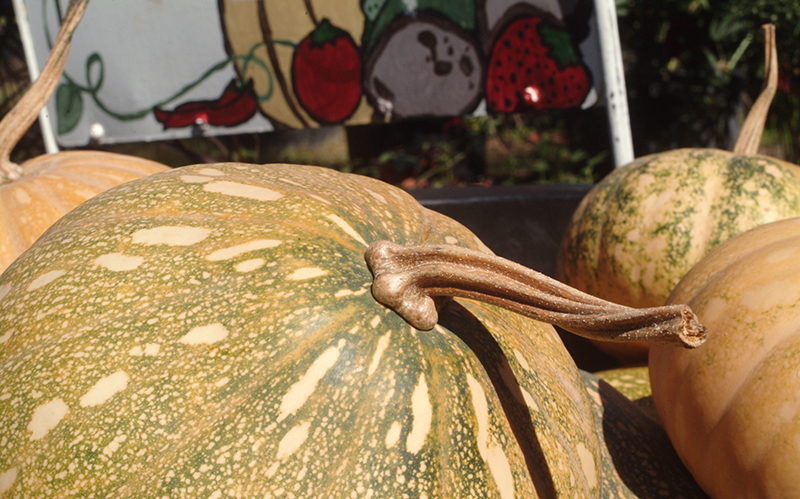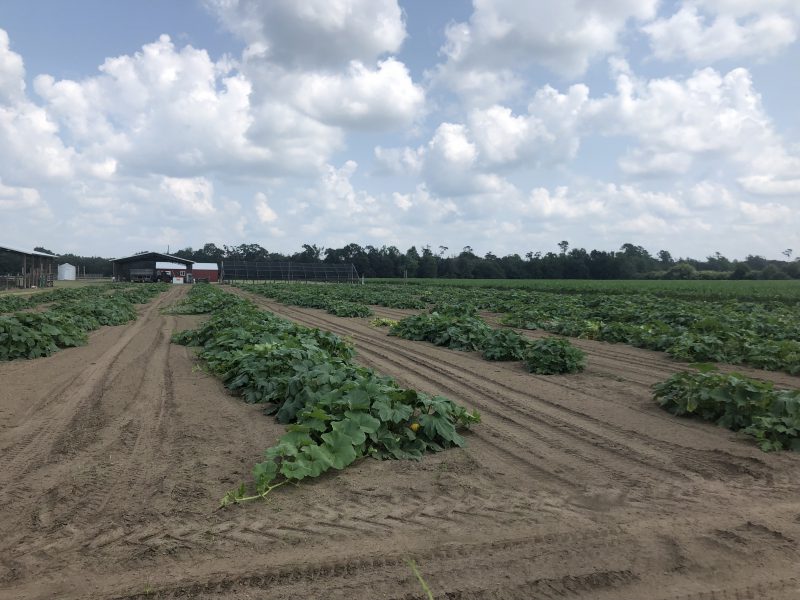
Seminole pumpkins. UF/IFAS Photo: Sally Lanigan.
Now that the summer heat is bearing down on us, it’s time to start thinking of October. That’s right, I said October. When we think about October, we think about cooler days, fall harvests, and Halloween. Unfortunately, the typical jack-o’-lantern pumpkins are very difficult to grow in this part of the country, due to hot, humid days, diseases, and insect pests. However, a pumpkin that can better withstand these extreme conditions does exist.
The Seminole pumpkin is a variety of the Cucurbita moschata species, which also includes butternut squash and calabaza squash (Cuban pumpkin). Seminole pumpkins can range in color from green to cream orange. Mature fruit are generally 6 to 12 pounds. The flesh of the fruit is less stringy and firmer than traditional pumpkins, and tastes sweeter than butternut squash and pie pumpkins. The pumpkins have thick skin and can be stored for up to year in a well ventilated, dry location.

Pumpkins growing on a North Florida farm. Photo Credit: Matt Lollar, University of Florida/IFAS Extension – Santa Rosa County
As stated earlier, Seminole pumpkins can withstand hot and humid weather. Fruit are ripe within 60 to 90 days when planted from seed. Vines of this species are vigorous, so seed should be planted at a spacing of at least six feet between rows, and four feet within the row. Cultural practices and fertilizer rates for Halloween pumpkins can be followed for Seminole pumpkin production. For production guidelines, please refer to the Vegetable Production Handbook for Florida: Cucurbit Production. Just like other cucurbit species, bees are necessary for good pollination and seed set.
Unfortunately, Seminole pumpkin seed sources are more scarce than typical commercial varieites. But, pumpkin seed can easily be saved from fruit purchased from the market or local farms. Just harvest the seed from the purchased pumpkin, rinse with water, allow to dry, and place in a bag or jar in the fridge or other cool, dry location. If you can’t find a seed source and don’t care to save seed, then you may want to give one of the two Florida-developed varieties of calabaza a try: ‘La Primera’ or ‘La Segunda’. Yields of calabaza varieties in South Florida range from 20 to 25 tons per acre.
So if you’d like to add Agritourism to your operation or if you’d like to grow a tasty unique variety, you might want to give Seminole pumpkins a try.
- Crops to Consider for Fall Planting - September 26, 2025
- Benefits of Manure Fertilizers and Analysis - March 21, 2025
- Mushrooms – A Crop Worth Consideration for the Back Forty - October 4, 2024
